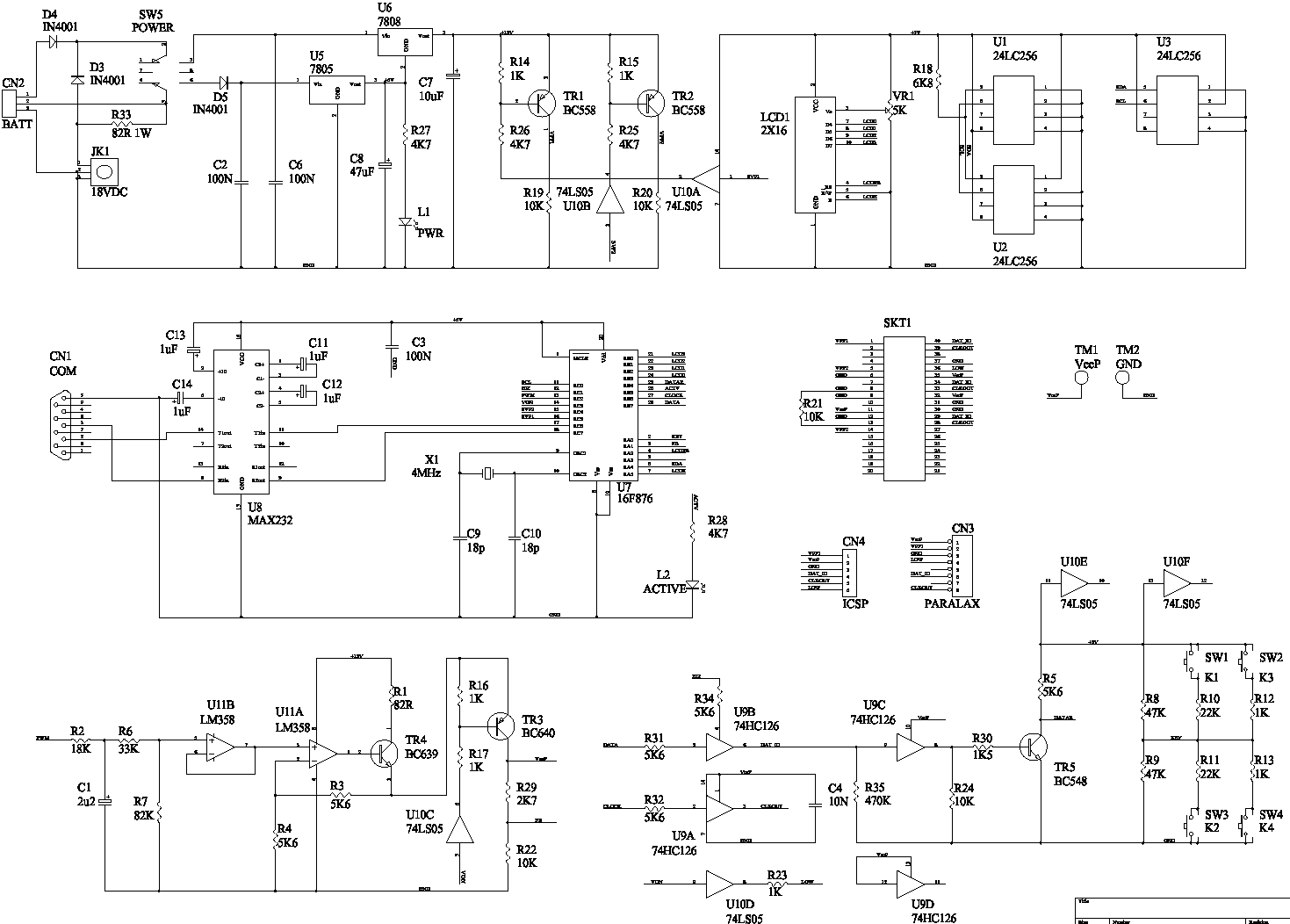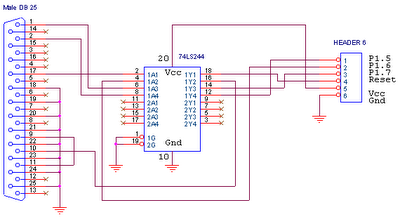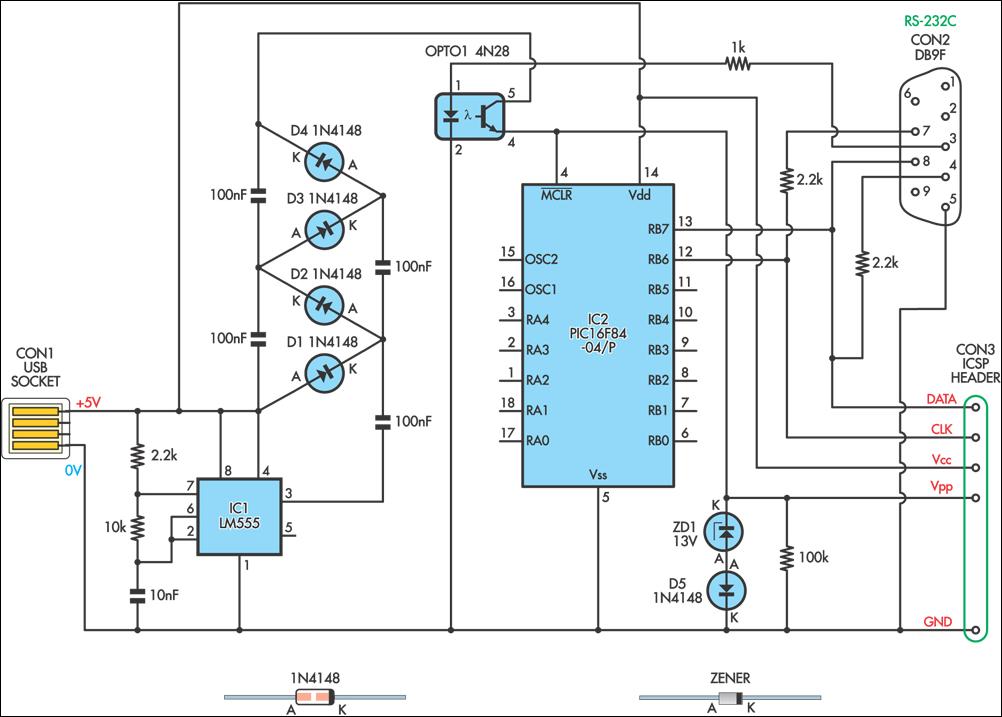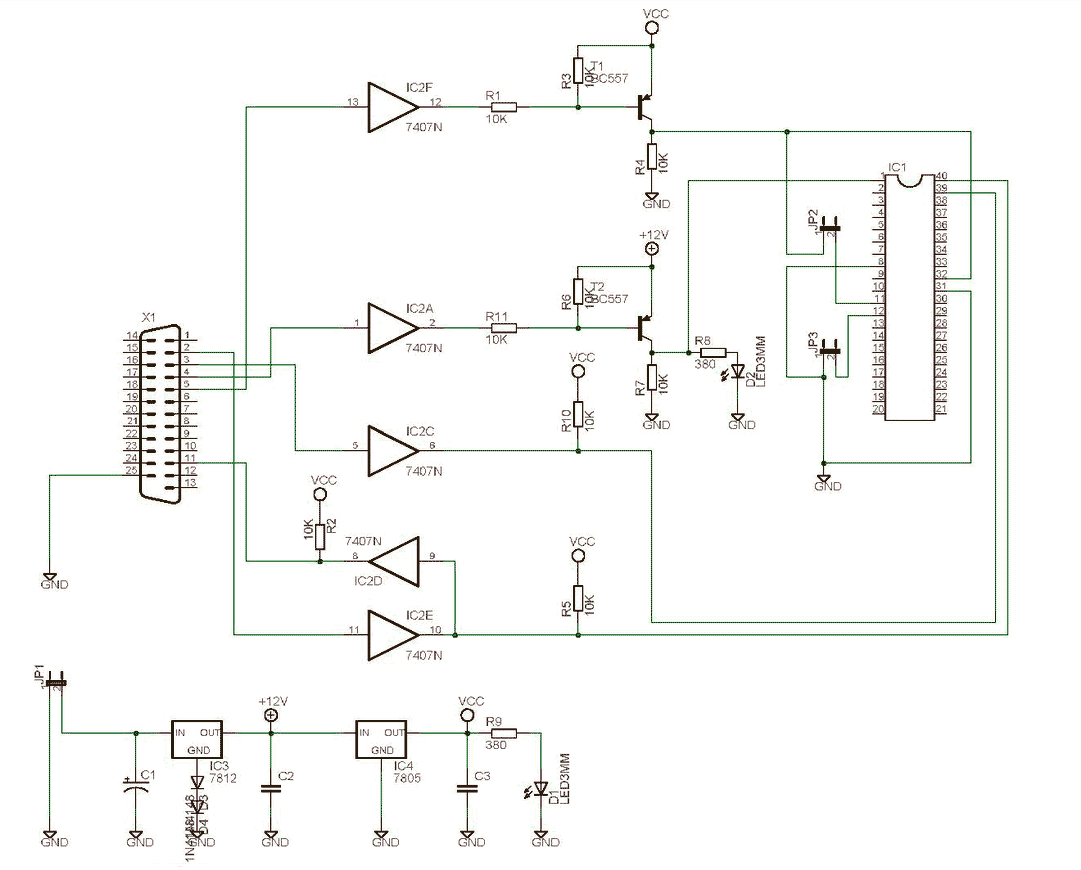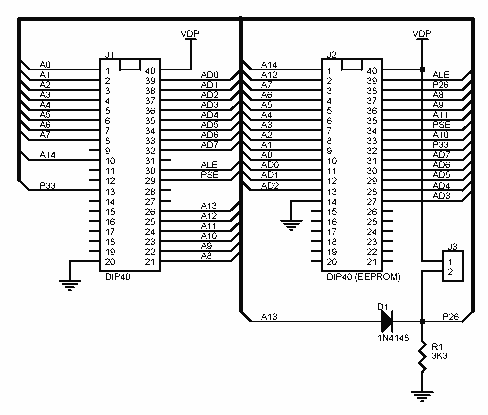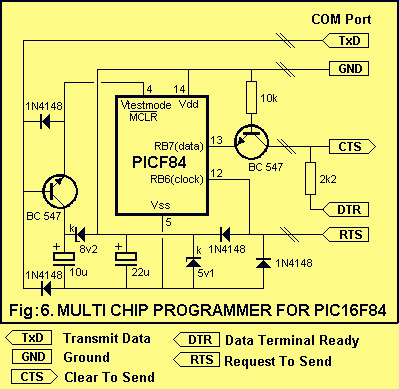
Programmer
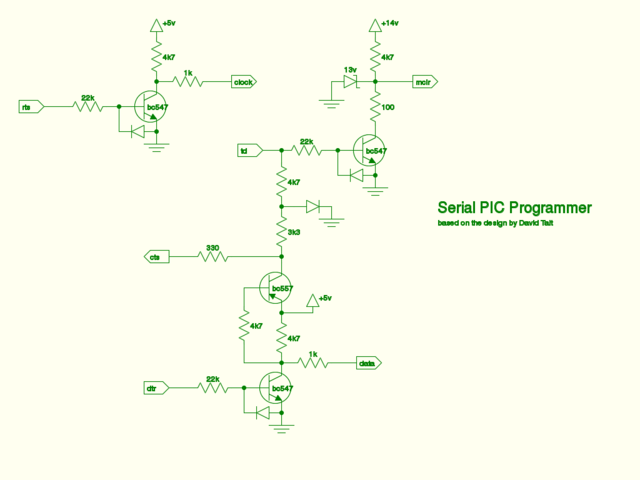
Circuit schematic for the classic PIC serial programming cable. A high-resolution version of the image and a Scalable Vector Graphics (SVG) source file for printing are also available. It is important to note that the SVG file may not display correctly in some browsers. Microcontrollers typically require specialized hardware for programming from a computer. The cable can be as simple as a few wires, resistors, and diodes connecting the parallel printer port to the microcontroller hardware, or it may include a microcontroller of its own to mediate between the computer software and the microcontroller. This simple circuit serves as a good compromise. It operates via the serial port of the PC and is capable of programming most types of PIC microcontrollers. It is commonly used to configure and load a bootstrap program into a new, blank microcontroller. Once the bootstrap program is installed, the serial programmer can be removed, allowing the computer to communicate with the bootstrap program to update and interrogate the microcontroller using a standard serial cable. The software for programming PIC microcontrollers is contained in the files serial.lisp and controller.lisp. These files have been extensively utilized with PIC16F84 microcontrollers and have been enhanced to leverage the features of PIC16F88 microcontrollers.
The PIC serial programming cable circuit schematic illustrates a straightforward design that facilitates the programming of PIC microcontrollers through a serial interface. The circuit generally consists of a few essential components, including resistors, diodes, and connecting wires, which link the serial port of a computer to the microcontroller. The simplicity of the design allows for easy implementation and troubleshooting, making it accessible for hobbyists and professionals alike.
The circuit typically includes a level-shifting mechanism to ensure compatibility between the voltage levels of the computer's serial port and the microcontroller's programming interface. This is crucial for preventing damage to the microcontroller and ensuring reliable communication. Additionally, the circuit may incorporate a small microcontroller that acts as an intermediary, managing the data transfer and command execution between the computer and the target microcontroller.
When programming a new PIC microcontroller, the initial step involves loading a bootstrap program. This program is essential for establishing communication protocols and enabling further programming tasks. Once the bootstrap is successfully loaded, the serial programmer becomes unnecessary, as the computer can directly communicate with the microcontroller through the established serial connection.
The software files, serial.lisp and controller.lisp, provide the necessary code for the programming process. These files contain routines for sending commands and data to the microcontroller, as well as for receiving information back from it. The extensive use of these files with PIC16F84 microcontrollers demonstrates their reliability and effectiveness, while the enhancements made for PIC16F88 microcontrollers allow users to take advantage of additional features and capabilities offered by the newer model.
In conclusion, the PIC serial programming cable circuit schematic represents a practical solution for programming PIC microcontrollers, combining simplicity with functionality. It provides a robust method for loading programs and facilitating communication between a computer and microcontroller, making it an invaluable tool for developers and engineers working with PIC technology.Circuit schematic for the classic PIC serial programming cable. There is also a high resolution version of the image, and a Scalable Vector Graphics source file for printing. Please note that the SVG file might not display properly in some browsers. Microcontrollers generally require special hardware for programming them from a computer. The cable can be as simple as a few wires, resistors and diodes connecting the parallel printer port to the microcontroller hardware, or it can contain a microcontroller of its own to mediate between the computer software and the microcontroller. I`ve found this simple circuit to be a good compromise. It works via the serial port of the PC and is capable of programming most kinds of PIC microcontrollers.
Typically it is used to configure and load a bootstrap program into a new blank microcontroller. Once the bootstrap program is in place, the serial programmer may be dispensed with and the computer can communicate with the bootstrap program to update and interrogate the microcontroller via a normal serial cable. The software for programming PIC microcontrollers with this is in these files: serial. lisp and controller. lisp They have been extensively used with PIC16F84 microcontrollers and more recently they have been enhanced to take advantage of the features of PIC16F88 microcontrollers.
🔗 External reference
The PIC serial programming cable circuit schematic illustrates a straightforward design that facilitates the programming of PIC microcontrollers through a serial interface. The circuit generally consists of a few essential components, including resistors, diodes, and connecting wires, which link the serial port of a computer to the microcontroller. The simplicity of the design allows for easy implementation and troubleshooting, making it accessible for hobbyists and professionals alike.
The circuit typically includes a level-shifting mechanism to ensure compatibility between the voltage levels of the computer's serial port and the microcontroller's programming interface. This is crucial for preventing damage to the microcontroller and ensuring reliable communication. Additionally, the circuit may incorporate a small microcontroller that acts as an intermediary, managing the data transfer and command execution between the computer and the target microcontroller.
When programming a new PIC microcontroller, the initial step involves loading a bootstrap program. This program is essential for establishing communication protocols and enabling further programming tasks. Once the bootstrap is successfully loaded, the serial programmer becomes unnecessary, as the computer can directly communicate with the microcontroller through the established serial connection.
The software files, serial.lisp and controller.lisp, provide the necessary code for the programming process. These files contain routines for sending commands and data to the microcontroller, as well as for receiving information back from it. The extensive use of these files with PIC16F84 microcontrollers demonstrates their reliability and effectiveness, while the enhancements made for PIC16F88 microcontrollers allow users to take advantage of additional features and capabilities offered by the newer model.
In conclusion, the PIC serial programming cable circuit schematic represents a practical solution for programming PIC microcontrollers, combining simplicity with functionality. It provides a robust method for loading programs and facilitating communication between a computer and microcontroller, making it an invaluable tool for developers and engineers working with PIC technology.Circuit schematic for the classic PIC serial programming cable. There is also a high resolution version of the image, and a Scalable Vector Graphics source file for printing. Please note that the SVG file might not display properly in some browsers. Microcontrollers generally require special hardware for programming them from a computer. The cable can be as simple as a few wires, resistors and diodes connecting the parallel printer port to the microcontroller hardware, or it can contain a microcontroller of its own to mediate between the computer software and the microcontroller. I`ve found this simple circuit to be a good compromise. It works via the serial port of the PC and is capable of programming most kinds of PIC microcontrollers.
Typically it is used to configure and load a bootstrap program into a new blank microcontroller. Once the bootstrap program is in place, the serial programmer may be dispensed with and the computer can communicate with the bootstrap program to update and interrogate the microcontroller via a normal serial cable. The software for programming PIC microcontrollers with this is in these files: serial. lisp and controller. lisp They have been extensively used with PIC16F84 microcontrollers and more recently they have been enhanced to take advantage of the features of PIC16F88 microcontrollers.
🔗 External reference
